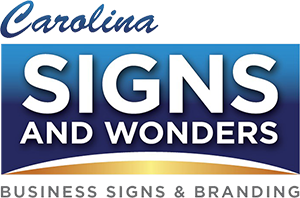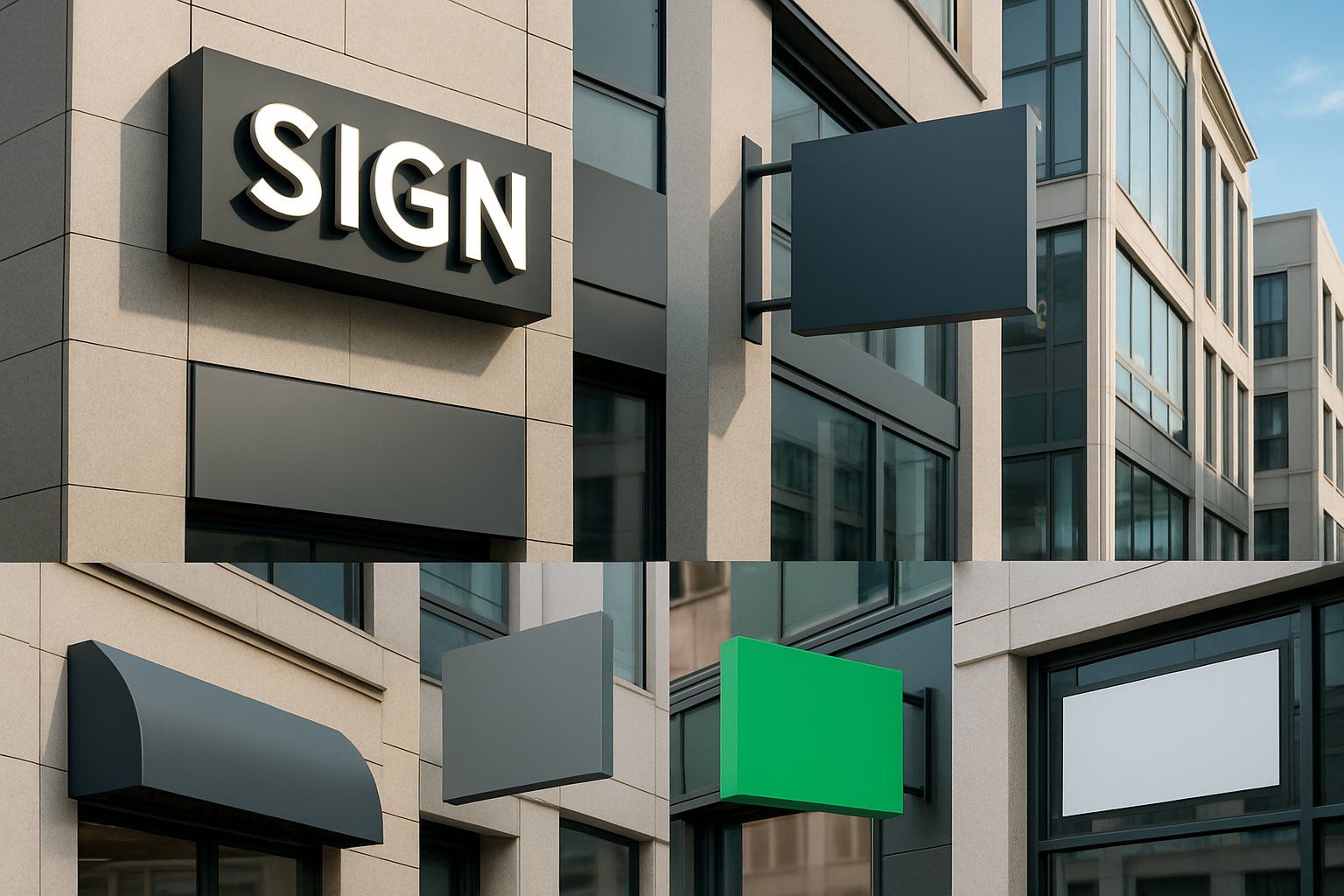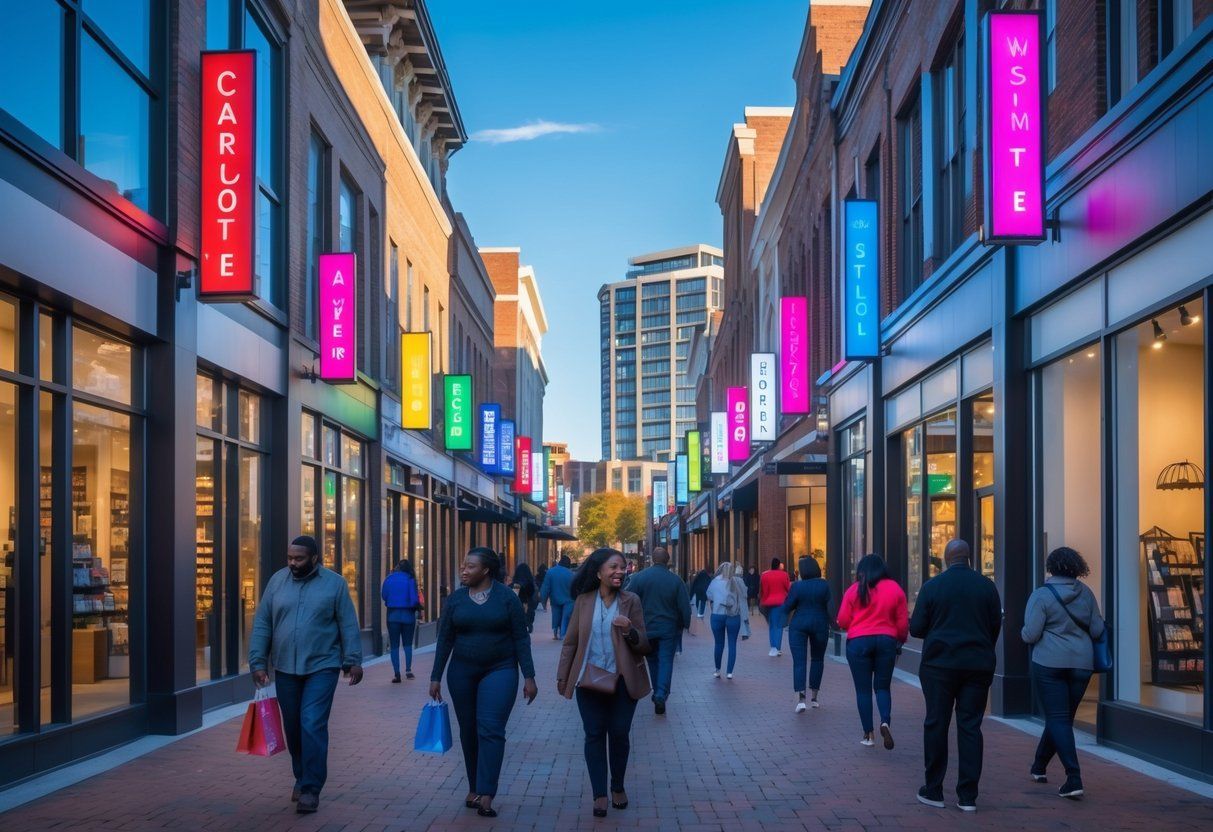Cabinet vs Channel Letter Signs for Business: Choosing the Best Signage for Visibility and Impact
Businesses often face the choice between cabinet signs and channel letter signs when deciding how to display their name or logo.
Cabinet signs are enclosed boxes that offer a cost-effective, classic look, while channel letter signs are individual, three-dimensional letters that provide a modern and bold appearance.
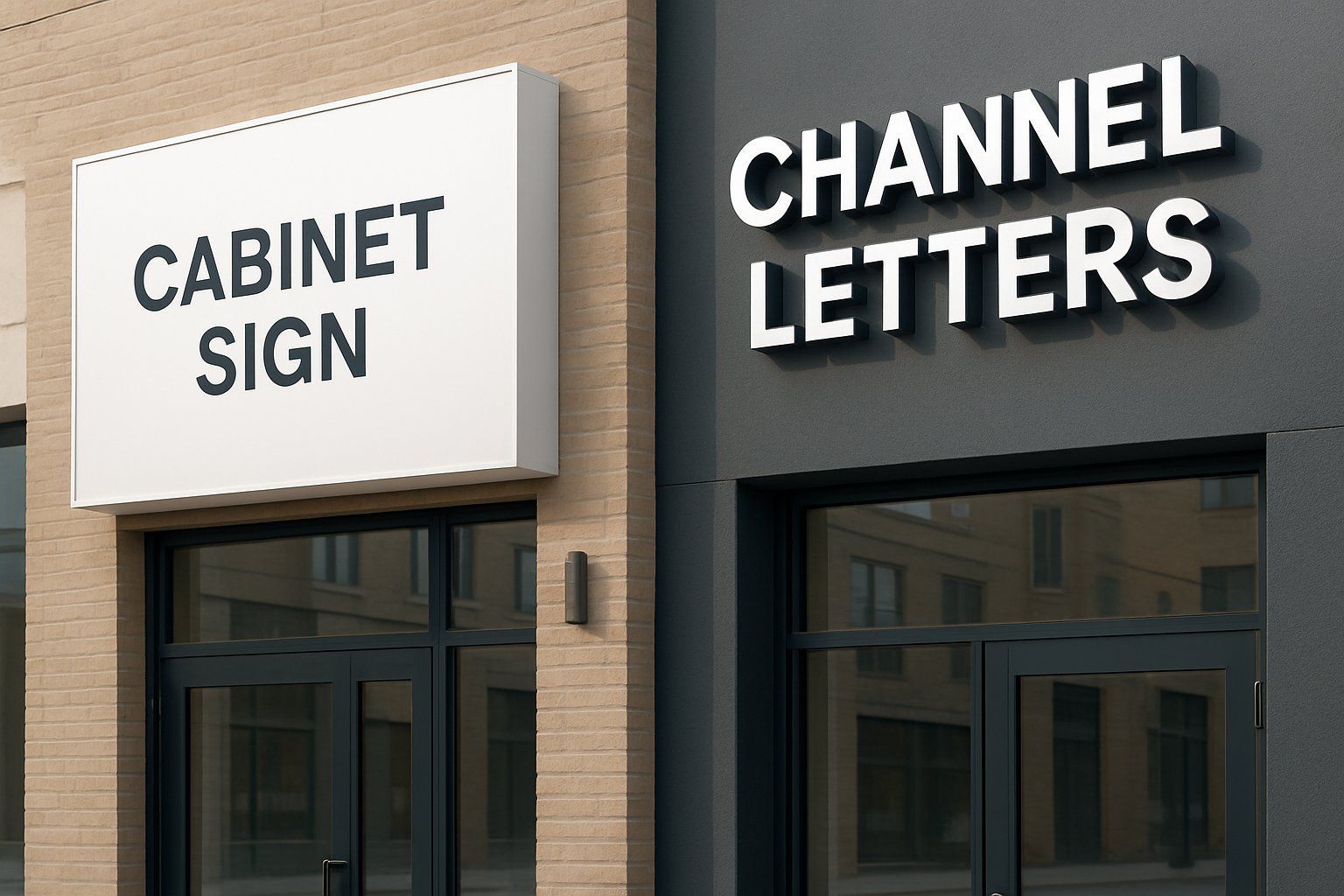
Each type has its advantages depending on factors like visibility, customization, and budget.
Understanding these differences helps business owners pick the best sign to attract customers and strengthen their brand.
Both signs have unique design features and maintenance needs that affect long-term performance.
Key Takeaways
- Cabinet signs are typically more affordable and simpler in design.
- Channel letter signs provide high visibility and customization options.
- Maintenance and installation needs vary between the two sign types.
Understanding Cabinet Signs and Channel Letter Signs
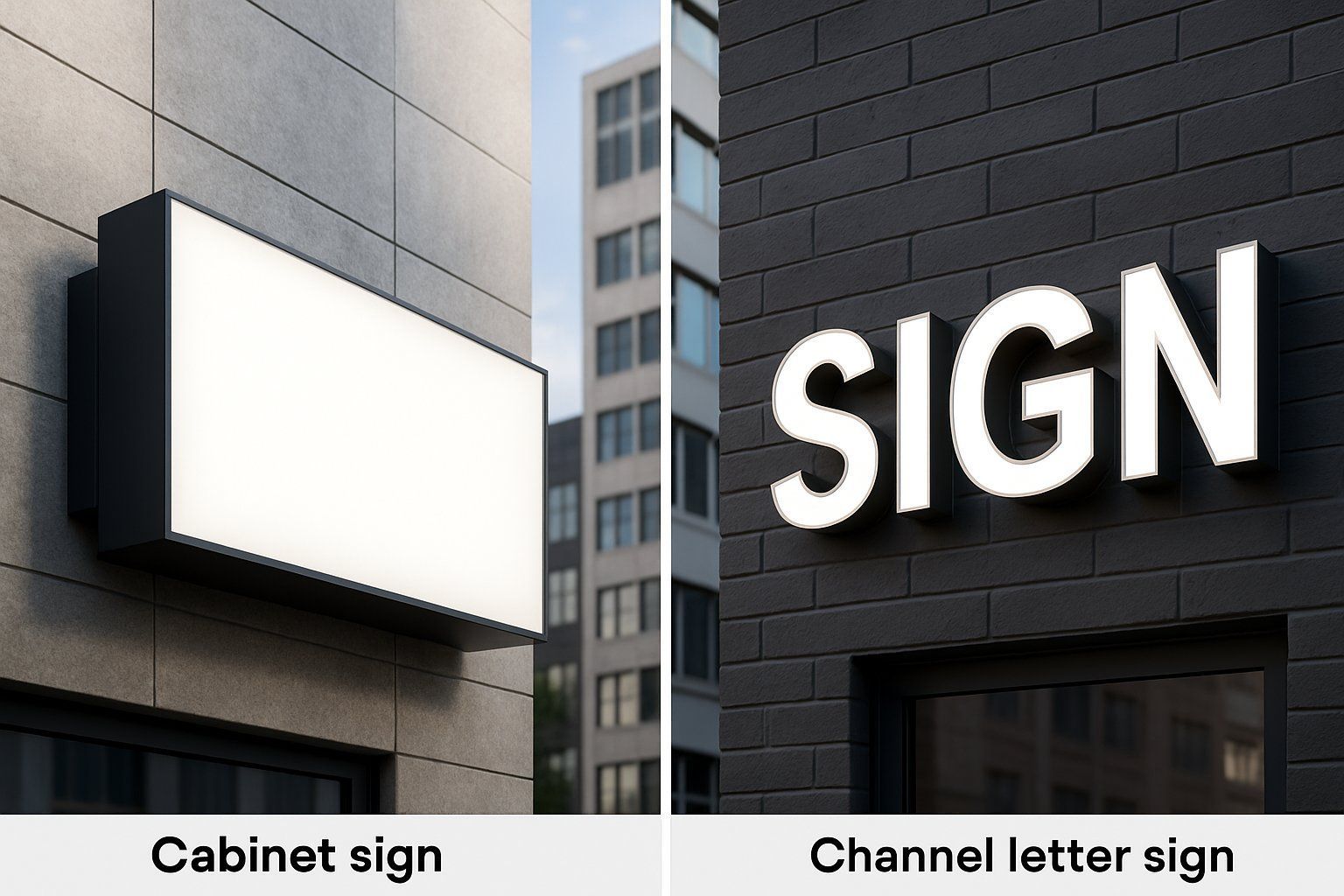
There are two main types of business signs that stand out: cabinet signs and channel letter signs.
Each offers a different look, size, and way of lighting.
Understanding their features helps businesses choose the right style for their signage needs.
What Are Cabinet Signs?
Cabinet signs, also called box signs or panel signs, are large, box-like structures.
They usually have a flat front surface where graphics, logos, or letters appear.
The face is often made of acrylic or metal and is lit from behind by LED or fluorescent lights.
These signs are enclosed, which protects the lighting and wiring inside.
Cabinet signs are often used for storefronts, malls, or building identification.
Their simple shape makes them easy to install and maintain.
They offer a clean and uniform look for displaying a business name or logo.
What Are Channel Letter Signs?
Channel letter signs are made up of three-dimensional letters or shapes mounted separately on a building.
Each letter is hollow and usually has LED lighting inside.
The letters can be made of metal or plastic and are often illuminated from within or from the back.
These signs create a bold and eye-catching look.
Businesses use them to display names clearly and attract attention at night.
Because the letters stand out from the surface, channel letter signs add depth and style.
They are customizable in size, font, and color.
Differences Between Cabinet Signs and Channel Letters
Shape and Design
- Cabinet Signs: Box-shaped, flat panel with a graphic face.
- Channel Letters: Individual, three-dimensional letters or shapes.
Lighting
- Cabinet Signs: Lit from inside the box, light spreads evenly across the face.
- Channel Letters: Lit inside each letter or from behind, creating a halo or front glow.
Installation
- Cabinet Signs: Mounted as one large unit.
- Channel Letters: Installed letter by letter.
Visual Impact
- Cabinet Signs: Solid, clean appearance.
- Channel Letters: Add depth and a high-end look.
Businesses choose between these based on brand style, budget, and visibility needs.
Key Features and Design Characteristics
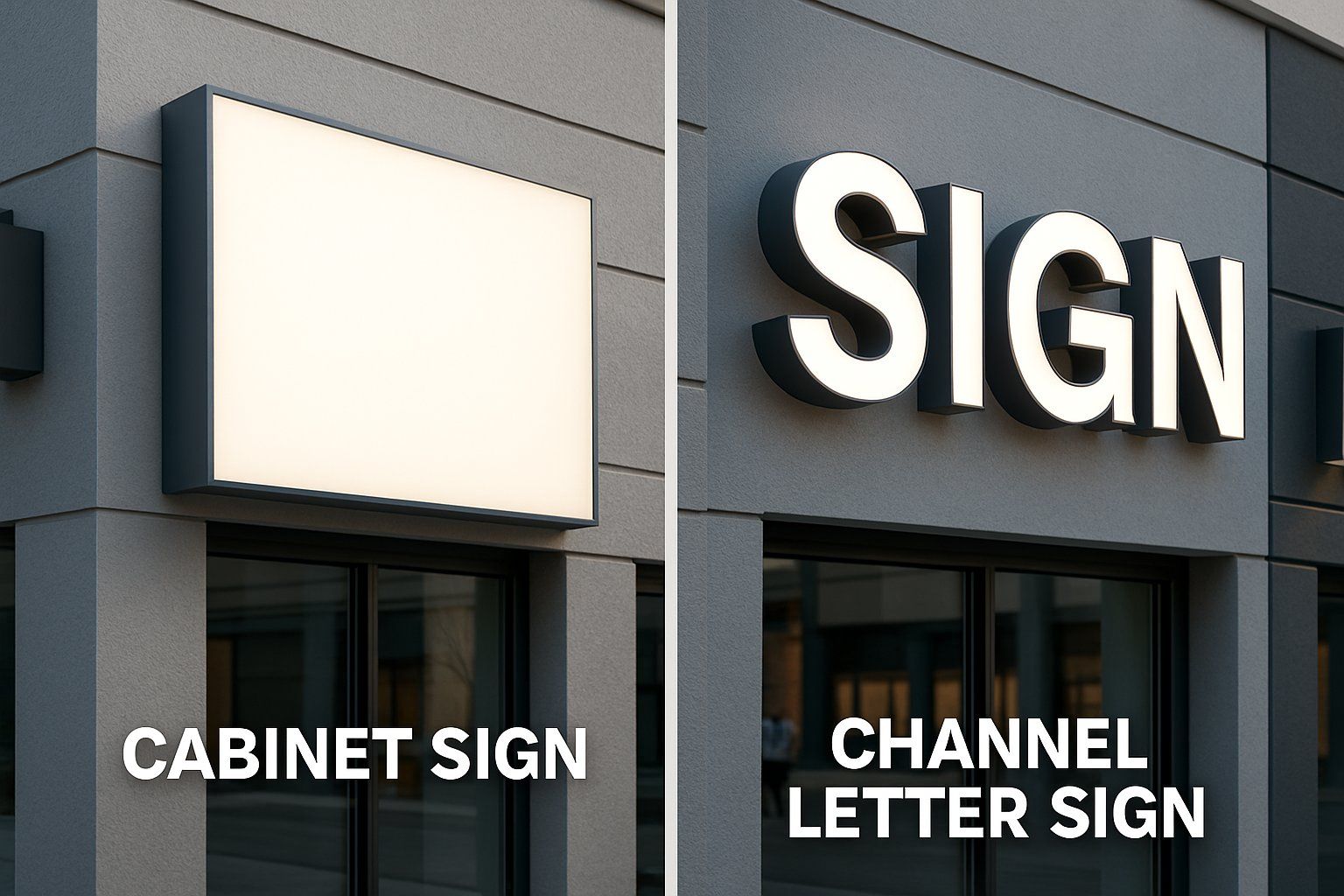
Business signs differ in how they are built, lit, and how they catch attention.
These differences affect their look, visibility, and how easy they are to read at a distance or in various lighting.
Materials and Construction
Cabinet signs usually have an aluminum frame that forms a box shape.
The front panels are made from acrylic or polycarbonate, which are durable and allow light to shine through if backlit.
The sides can be metal or vinyl, adding stability and style.
Channel letter signs are made with individual metal or acrylic letters.
Each letter has a hollow body and a translucent face, often made of acrylic, to let light out.
These letters are three-dimensional and can be mounted directly to walls, creating a raised effect.
Wood is rare but sometimes used in cabinet signs for a rustic look.
Vinyl is mostly for graphics or face coverings on cabinet signs, not channel letters.
Lighting Options and Illumination
Cabinet signs usually feature internal illumination with LED lighting.
Lights are placed inside the box behind a translucent face, allowing for even, soft lighting.
LED modules are common because they are energy-efficient and last longer than older lighting.
Channel letters often use front-lit LED modules inside each letter, making the face glow brightly.
Some channel letters are backlit, creating a halo effect around the edges.
Both lighting options improve visibility at night but create different visual styles.
Visual Impact and Readability
Cabinet signs offer a large, often rectangular surface that clearly displays logos or messages with solid backgrounds.
The illuminated face ensures letters and graphics stand out, helping with readability from far away or in low light.
Channel letters provide a bold, three-dimensional look that stands out on building walls.
Their individual and raised design increases depth and shadow, which aids readability.
The lighting inside each letter highlights shapes, making them easier to see from an angle or distance.
| Feature | Cabinet Signs | Channel Letter Signs |
|---|---|---|
| Shape | Box shape with flat face | Individual 3D letters |
| Materials | Aluminum frame, acrylic, vinyl | Metal body, acrylic face |
| Lighting | Internal LED modules | Front or backlit LEDs |
| Visual Style | Flat, bold graphics | Raised, dimensional appearance |
| Readability Distance | High from straight on | High from various angles |
Branding and Customization
Businesses need signs that clearly show their identity and attract attention.
The choice between cabinet and channel letter signs affects how well a brand’s message connects with people.
Visual appeal, the way graphics and text are displayed, and the level of customization all play key roles in reaching branding goals.
Brand Identity and Message
Cabinet signs often provide a solid background that supports a clear brand identity.
They create a framed look that makes logos and text stand out in a professional way.
This style suits businesses that want a consistent, easily readable presentation.
Channel letter signs offer a more modern aesthetic.
Each letter is a separate, three-dimensional element, which can create a bold statement.
They work well for brands that want to appear dynamic and highly visible from different angles.
Both types communicate the brand message but in different tones.
Cabinet signs lean toward tradition and clarity.
Channel letters highlight innovation and boldness.
The choice depends on the brand’s personality and target audience.
Graphics and Text Design
Cabinet signs allow for detailed graphics and complex text layouts.
Because of their flat backs, they can include full-color prints, logos, and images all in one face.
This makes them ideal for businesses needing rich, detailed visuals.
Channel letters use custom-shaped letters with lighting options often built-in.
This limits the use of graphics but makes the text itself pop.
The design focuses mostly on letter style, size, and illumination to attract attention, rather than detailed graphic elements.
Clear, readable text is crucial in both.
Cabinet signs give more room for artistic freedom with graphics.
Channel letter signs focus on clean, bold letterforms to ensure brand visibility, especially under low light or from a distance.
Customization Options
Cabinet signs offer wide customization in terms of size, shape, color, and materials.
They can incorporate multiple fonts and graphic styles.
Businesses can tailor them closely to match their branding guidelines and marketing needs.
Channel letters provide flexibility in letter shape, font, color, and lighting.
They allow for individual illumination choices like LED or neon, which enhances night-time visibility.
However, they are less flexible for large graphic elements.
Key customization features include:
- Cabinet signs: full graphic faces, multi-color printing, diverse materials (acrylic, metal).
- Channel letters: illuminated letters, varied letter depths, different fonts and finish types.
The level of customization should match the branding goals and budget for the most effective sign choice.
Performance and Durability
Cabinet and channel letter signs differ in how they handle weather, energy use, and visibility.
Each type suits different business needs depending on location, foot traffic, and desired impact.
Weather Resistance and Lifespan
Cabinet signs typically have a solid metal or plastic box that protects the internal lighting and components from rain, wind, and snow.
This enclosure helps prevent damage and extends the sign’s lifespan, especially in harsh weather.
Channel letter signs are made from durable materials like aluminum and acrylic.
They have some open space behind the letters, which can allow moisture or dirt inside if not sealed properly.
However, high-quality channel letters use weather-resistant coatings and gaskets to improve durability.
Businesses in areas with heavy rain or snow often prefer cabinet signs for their stronger protection.
Channel letters may require more maintenance but still last well if installed and sealed correctly.
Energy Efficiency
Channel letter signs often use LED lighting, which is more energy-efficient than traditional bulbs.
LEDs consume less power, offer brighter illumination, and last longer.
This makes channel letters a good choice for businesses wanting to reduce energy costs.
Cabinet signs can also use LED lighting, but their internal space can sometimes reduce light distribution efficiency.
Older cabinet signs might still use fluorescent tubes or neon, which use more power.
For energy savings, businesses should look for signs with LED technology and consider brightness and run time based on their location and visibility needs.
Visibility and Effectiveness
Channel letter signs provide high visibility because the letters stand out from the building facade.
This gives a 3D effect that is easy to read from a distance and at different angles.
They work well in high-traffic areas where quick recognition is critical.
Cabinet signs offer a flat display with illumination behind a face, usually showing the business name or logo.
They can be effective but might not stand out as much as channel letters, especially on busy streets.
For clear, effective signage, businesses should match sign type to their location and how they want to attract customers.
Cost and Value Considerations
Choosing between cabinet signs and channel letter signs depends on budget, durability, and long-term costs.
Affordability, initial expenses, and maintenance all play a key role in deciding the best option for a business.
Affordability and Upfront Costs
Cabinet signs often have a lower upfront cost because they use simpler materials and construction.
They usually consist of a single box with a printed or vinyl graphic, which makes them cheaper to produce.
Channel letter signs use individual 3D letters with lighting, which requires more materials and skilled labor.
This makes their initial price higher than cabinet signs.
Businesses with a tight budget may prefer cabinet signs for easier affordability.
However, channel letters offer a more modern look but at a greater upfront cost.
Investment and Return on Investment
Channel letter signs can attract more attention because of their depth and lighting.
This visibility can increase customer visits, providing a better return on investment despite being pricier.
Cabinet signs offer less visual impact but still serve well for clear, basic branding.
Their ROI depends on location and target audience.
Businesses should weigh the benefit of increased visibility against the initial expense when deciding which sign matches their goals.
Long-Term Cost-Effectiveness
Channel letter signs tend to last longer because they are made from durable materials like aluminum and acrylic.
Maintenance costs can be lower if they use energy-efficient LEDs.
Cabinet signs may require more frequent repairs or replacement of the graphic face due to weather wear.
This can raise long-term expenses.
Although channel letters cost more initially, their longer lifespan and lower upkeep often make them more cost-effective over time.
Installation and Maintenance Factors
The choice between cabinet and channel letter signs affects how easy the sign is to install and how much upkeep it will need.
Different mounting options and materials influence both the installation process and the long-term care.
Installation Complexity and Mounting Types
Cabinet signs often require flush mounting against walls or raceway mounting for easier access to electrical components.
Raceway mounting lets installers hide wiring in a metal box behind the sign, simplifying installation on uneven surfaces.
Channel letter signs usually demand more precise installation.
Each letter is mounted separately, which takes more time and skill.
They can be mounted directly on walls or on a raceway.
This flexibility lets installers customize spacing but adds to complexity.
Both types need sturdy materials for secure mounting.
However, channel letters can be heavier and require stronger anchors.
Loose wiring and incorrect mounting in either style can cause safety issues or damage.
Maintenance Needs and Longevity
Cabinet signs have easier maintenance because all lights and wiring are inside one large box. This protects components from weather, making repairs faster and less frequent.
Channel letter signs require more regular maintenance. Since each letter is separate, moisture or dirt can build up between them.
Cleaning and repairing can take longer, especially if some letters need removal.
Both signs last long if made with quality materials. LED lighting common in both reduces energy use and bulb replacements.
However, cabinets generally show less wear over time due to their protected design.
Choosing the Right Sign for Your Business
Choosing a sign depends on clear goals and practical needs. A business must think about how the sign supports its brand, the type of customers it wants to attract, and where the sign will be placed.
Different signs fit different styles and locations.
Matching Signage to Business Goals
A sign should match what a business wants to achieve with its brand. If a company wants strong brand recognition and visual appeal, channel letters often work well.
They stand out with bright lighting and a modern look, which helps boost branding impact.
For businesses focused on clear messaging or affordability, cabinet signs can be a good fit. They offer a simple space to display logos and information, helping reach the target audience without high costs.
Best Uses for Cabinet Signs
Cabinet signs are good when a business needs a clear and solid display. They work well for stores in shopping centers or strip malls where foot traffic is steady but not intense.
These signs typically have a box shape with printed graphics or faces. They offer a clean look and can show detailed logos or multiple colors easily.
They fit businesses with smaller budgets or those needing basic visibility rather than bright lighting or 3D shapes. Cabinet signs perform well for companies wanting easy and cost-effective branding.
When to Choose Channel Letter Signs
Channel letter signs are best for businesses wanting high visibility and a strong visual appeal. They are custom-shaped 3D letters or logos that can be lit from inside.
This makes them easy to see day or night, drawing more attention from people passing by.
They fit businesses with goals like standing out in busy areas or attracting foot traffic from a distance. Channel letters work well for retail stores, restaurants, and offices looking to boost brand recognition and create a modern, professional look.
These signs often require a bigger investment but deliver strong impact.
Summary of Pros and Cons
Cabinet signs and channel letter signs each have unique features that affect their use. Factors such as cost, durability, and design flexibility will guide the choice.
Advantages of Cabinet Signs
Cabinet signs are known for their versatility. They offer a solid, enclosed structure that protects the lighting and components from weather damage.
This makes them very durable in different climates. They can display large graphics or logos clearly, which is helpful for branding.
The flat face allows easy customization with different colors and fonts. Cabinet signs are usually less expensive to install compared to channel letters.
Maintenance is simpler because all parts are inside one box, reducing the chance of individual element failure. They are a good choice for businesses wanting a bold, consistent look at a lower cost.
Benefits of Channel Letter Signs
Channel letter signs are highly flexible in design. Each letter or logo piece is separate, which allows for unique shapes and 3D effects.
This can make a business name stand out more visually. They often use LED lighting which makes them brighter and more energy-efficient.
Channel letters can be illuminated from inside or behind (halo lighting), offering more creative options. These signs usually last longer because individual letters can be repaired or replaced without changing the whole sign.
They fit well on varied building surfaces due to their lightweight design.
Potential Drawbacks of Each Type
Cabinet signs tend to be heavier and bulkier, which can limit where they are installed. Their box-like shape might restrict design options for some businesses.
They can cost more if complex graphics are needed. Channel letter signs are usually more expensive to produce and install because of their custom shapes.
They may require more maintenance since each letter is a separate unit exposed to weather. Both types need proper installation to avoid damage and uneven lighting.
Maintenance costs vary, but channel letters can be pricier to fix due to their complexity. Cabinet signs are simpler but might not attract as much attention in busy areas.
Frequently Asked Questions
Cabinet signs and channel letter signs differ in structure, cost, maintenance, and installation. Each type offers unique benefits and challenges depending on a business’s needs and location.
What are the key differences between cabinet signs and channel letter signs?
Cabinet signs are box-shaped with a flat face, often showing a logo or text. Channel letter signs are three-dimensional, typically shaped like individual letters with lighting inside.
Can you break down the cost comparison for cabinet signage versus channel letter signage?
Cabinet signs usually cost less upfront because they are simpler in design. Channel letter signs can be more expensive due to their custom shapes and lighting features.
What are the typical maintenance considerations for channel letter and cabinet signs?
Cabinet signs may need less frequent repairs but can fade over time. Channel letters require regular checks for lighting and wiring to keep them working well.
What advantages do channel letter signs offer over cabinet signs?
Channel letters stand out more due to their 3D design and lighting. They can be easier to read from a distance, especially at night.
How do reverse channel letters differ from standard channel letters in signage?
Reverse channel letters have lighting that shines on the wall behind them, creating a halo effect. Standard channel letters light up the face or front of the letter.
When selecting signage, how does the installation process vary between cabinet and channel letter options?
Cabinet signs are installed as one large unit. They usually require wall anchors.
Channel letters are installed one piece at a time. Often, each letter has individual electrical connections.…

